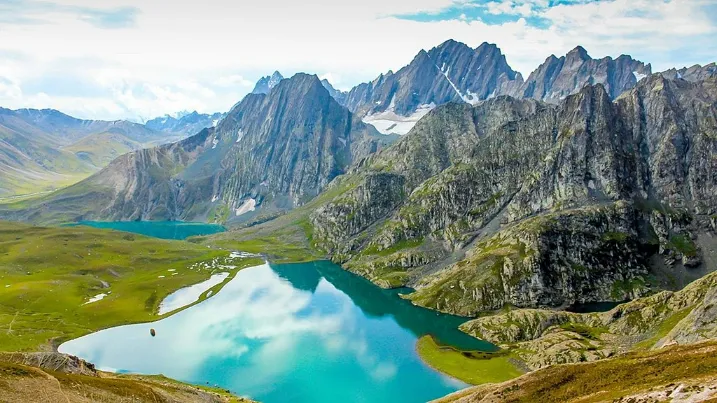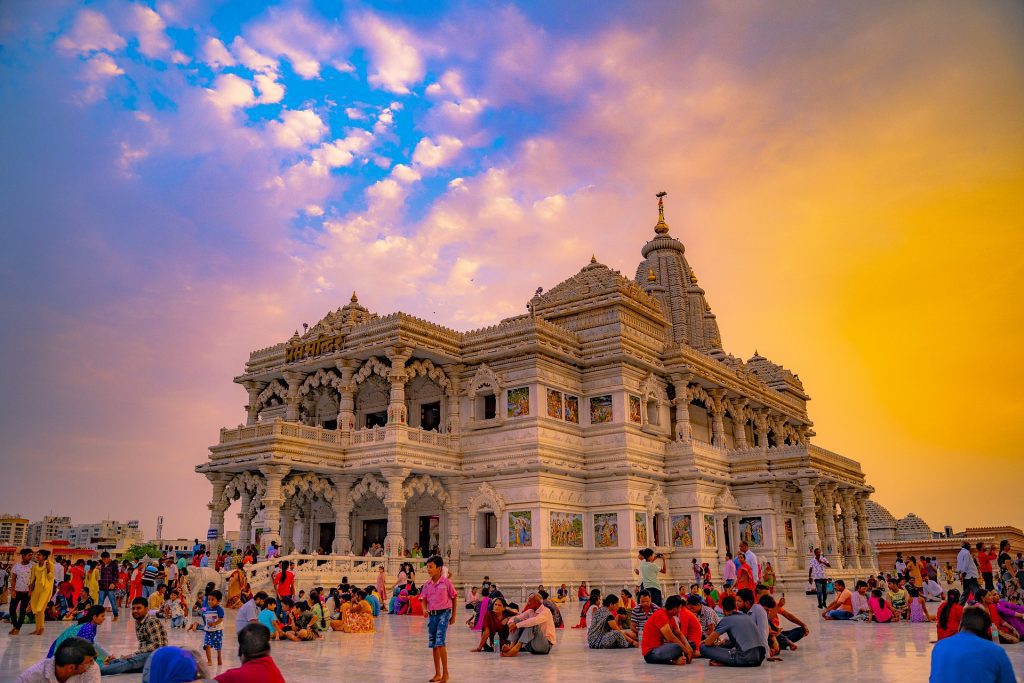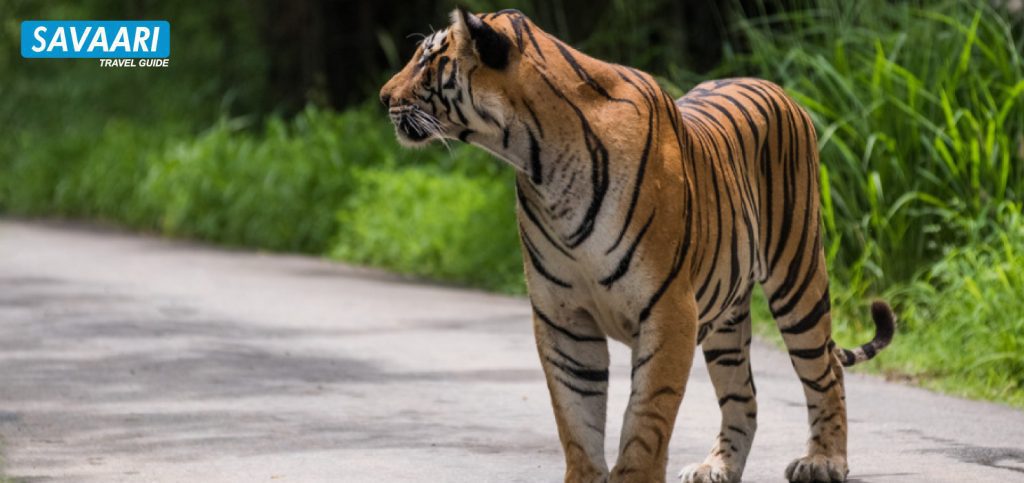
Table of Contents
- About Sundarbans National Park
- Things to do in Sundarbans
- How to Plan a trip to Sundarbans National Park
- Resorts & Hotels to stay in Sundarbans
About Sundarbans National Park
The Sundarbans is the world’s largest Mangrove forest. It derives its name from “Sundari” trees which dominate the mangrove area. A confluence of River Ganga, Brahmaputra, and Meghna, its tributaries and creeks give its unique ecosystem and biodiversity. The Sundarbans National Park is a biosphere and tiger reserve and a UNESCO World Heritage site located about 100-110 kms from Kolkata, spread over an area of 1,330 km². The jungles are a popular attraction for tourists in Kolkata and is typically explored by booking a cab from the capital city.
Sundarban – World Heritage Site
The Sundarbans boasts a wide range of fauna, with over 260 species of birds. It is located in a unique bioclimatic zone and a landmark of ancient heritage of events – both historical and mythological. It also shelters endangered species such as the Estuarine crocodile, Indian python, Irawadi Dolphins, and critically endangered Batagur Baska (a species of riverine turtle). The national park is also the home to the globally endangered Royal Bengal Tiger and the only mangrove habitat in the world for Panthera tigris. It has approximately 78 species of mangroves and a varied cluster of islands and mudflats.
Owing to being the natural habitat of the aforementioned threatened species, the Sundarbans was declared as the UNESCO World Heritage Site in 1987.

Wildlife and Vegetation
“The Royal Bengal Tiger” in all its glory calls the Sundarbans it’s home. It hosts a modest population of about 400-450 Tigers. Its varied variety of 260 species of birds, 59 reptiles, and rich marine life makes this a must-visit for adventure seekers. This exceptional biodiversity supports 334 plant varieties, 165 algae and 13 orchid species, and much more.
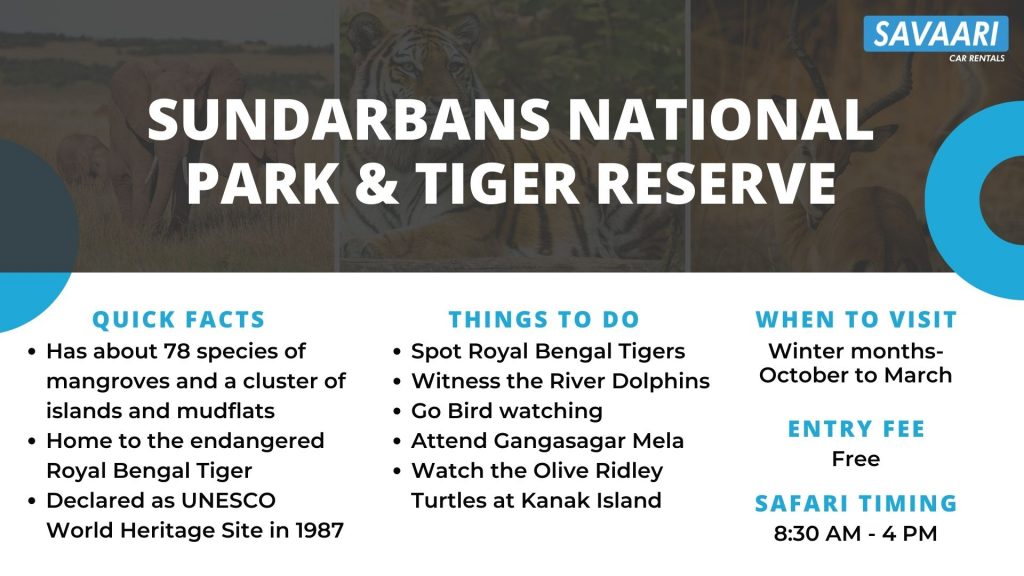
Interesting Facts about Sundarbans National Park
Here are some interesting facts about the Sundarbans:
- The Sundarbans is home to the Royal Bengal Tiger. Interestingly, a Sundarbans tiger is known for hunting humans more than any other tigers around the world.
- The Sundarbans jungle is part of the largest delta in the world. It has brackish waters, unique flora and fauna, mudflats, islands, and villages that make every visit unique.
- The Sundarbans mangrove forest is the largest mangrove ecosystem in the world. It houses the species Heritiera fomes also known as ‘Sundari’ locally which gives the forest its name. Of the fifty mangrove species in the world, twenty-six grow in the Sundarbans.
Things to Do in Sundarbans
- Spot the Royal Bengal Tigers. While this requires some amount of luck since tigers are very secretive and predicting their movement can be difficult, talk to local operators before visiting the place.
- Witness the River Dolphins. Sundarbans is one of the few places in India where you can watch dancing River Dolphins in India.
- Bird Watching. In the northern part of the Sundarbans Reserve, you can visit the Sajnekhali Bird Sanctuary to spot some exotic birds and fascinating land creatures.
- Village tours. Sundarbans has a rich tribal culture and many villages that you can visit and immerse yourself in the rural lifestyle and culture.
- Night Safari. Another unforgettable attraction is the mesmerizing sight of Phytoplanktons. Go for a night safari and witness the glow-in-dark phytoplanktons.
Things to Do around Sundarbans National Park
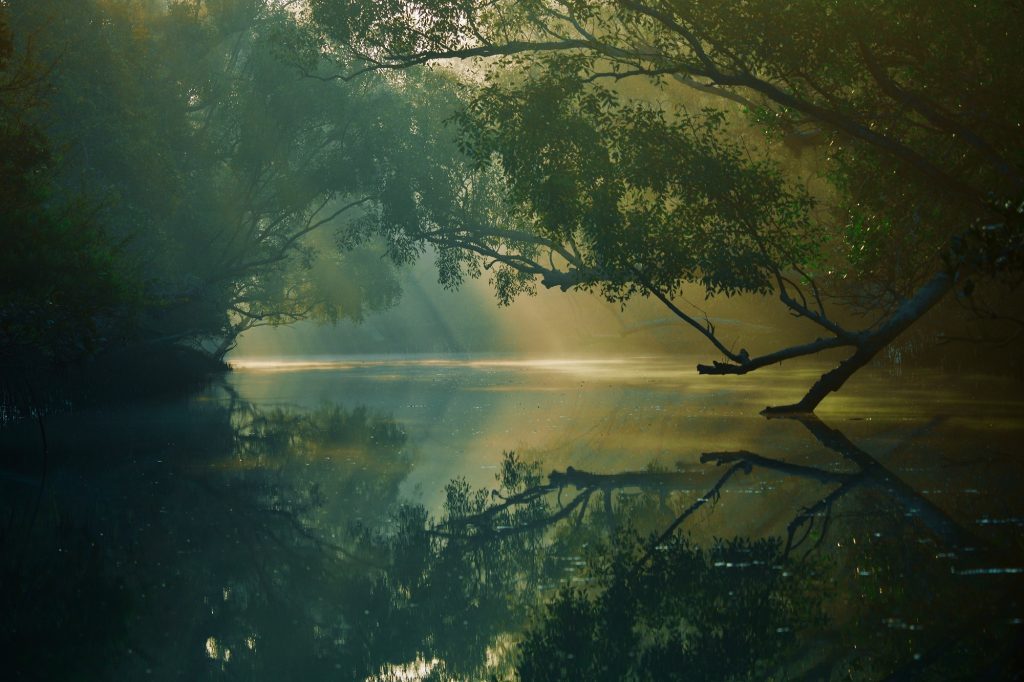
- A day tour of Kolkata.
- Spotting the Royal Bengal Tiger and River Dolphins
- Visiting the Sajnekhali Bird Sanctuary
- Visiting the Bhagabatpur Crocodile Project
- Attend the Gangasagar Mela in Sagar Island of Sundarban (January 14-15)
- Watch the Olive Ridley Turtles at Kanak Island
- Explore the Sundarbans through various watchtowers spread across the park
Places to Visit in Sundarbans
1. Sudhanyakhali Watch Tower
This watchtower is adjoining a sweet water pond making it an ideal spot to capture a glimpse of all the thirsty animals reaching there to quench their thirst. The grassland surrounding the tower also makes it a perfect spot to watch the animals grazing. While on a tour to the national park, you may be lucky to see the Royal Bengal tiger trying to catch prey or just play with its cubs offering a visual treat to wildlife lovers. Its close proximity to the park makes it a great choice to overlook the wild. It can accommodate approximately 20-25 people at a time.
2. Henry Island
Explore the serene beach of Henry on foot or explore the dense mangrove jungle. Crossing the tiny bamboo bridge is fun in itself. The local fishery department maintains 50 odd ponds to breed fishes. Watching the various colorful fishes swimming in these ponds is a great way to relax your mind.
How to Reach
Around 4 km before Bakkhali, you can take a left at the Jelighat stop and drive around 1.5 km to reach the lodges.
Best Time to Visit
While you can visit Henry’s Island throughout the year, winters are very pleasant with temperatures varying between 15-20 degrees during the day and 8-10 degrees at night.
3. Kalash Island
Don’t forget to visit Kalash if you are in Sundarbans in the winters. You will have a delightful experience watching thousands of Olive Ridley Turtles reaching the shores for nesting. Also, watch beautiful coastal birds you may end up coming face to face.
How to Reach
There are two preferred ways of reaching Kalash Island:
- Take the Diamond Harbor-Kulpi road to reach Ramganga and take a boat to the island.
- Approach the island via the Bidyadhari River from Bonnie Camp.
Best Time to Visit
Winters are very pleasant with temperatures varying between 15-20 degrees during the day and 8-10 degrees at night. Also, the Olive Ridley Turtles breed during the winter months.
4. Netidhopani
Netidhopani is another watchtower offering an amazing view of a 400-year-old Shiva temple and ruins of the Mughal settlements. These ruins take us back to the Mughal era when this land was leased to people staying nearby. It can host up to 20 people at a time.
5. Burirdabri Watch Tower
What makes Burirdabri famous is the watchtower which lets you see the Bangladesh Sundarbans. This watchtower can accommodate up to 10 people and is popularly known as the Raimongal View Point. There is also a mudwalk and mangrove cage trail.

How to Plan a trip to Sundarbans
How to Reach the Sundarbans from Kolkata
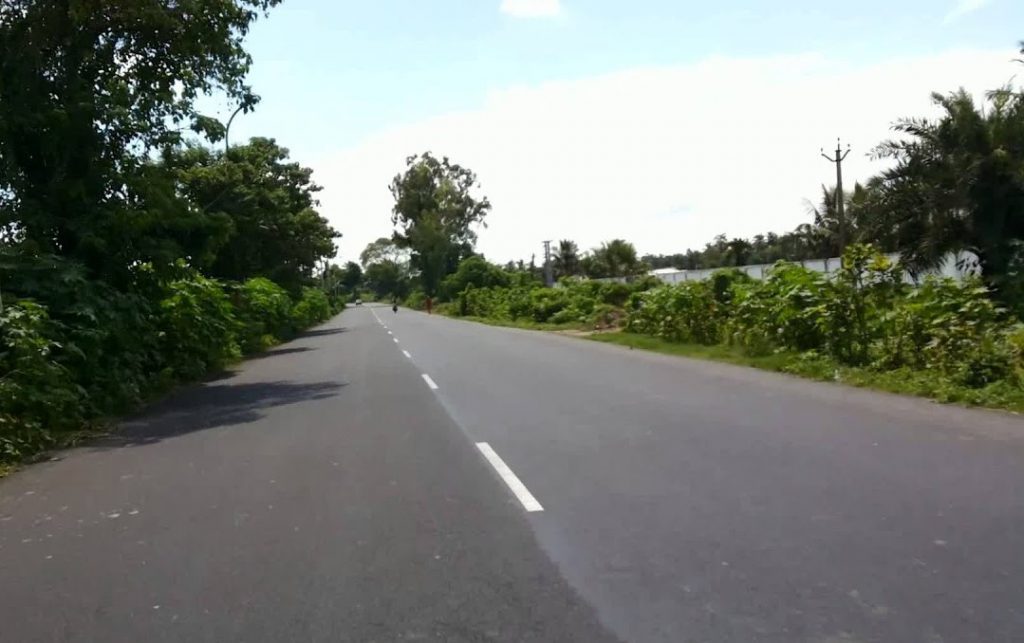
The National park is located at a distance of around 100-110 km from Kolkata. Here are some ways to reach Sundarbans from Kolkata:
- By Train – Sealdah is the closes major railway station and Canning is the nearest local railway station. You can reach Sealdah from any location in India and then take a local train to get to Canning. From Canning, you can take a taxi to reach the entry point of the national park at Godkhali.
- By Road – To reach the national park by road, you can take the Baruipur-Canning road or the SH3 to reach Godkhali for an onward journey by ferry. The distance between Kolkata and Godkhali is around 80-85 km and the travel time is around 3-3.5 hours. You can book a taxi from Kolkata to Godkhali from Savaari for a memorable experience.
- By Flight – The Netaji Subhas Chandra Bose International Airport in Kolkata is the nearest airport. It is located at a distance of around 90-95 km from Godkhali. You can book a cab from Kolkata to Sundarbans that can take you to Godkhali within 3-4 hours. You can alternatively take a train or cab from Kolkata to Canning to reach the starting point of the ferry at Godkhali.
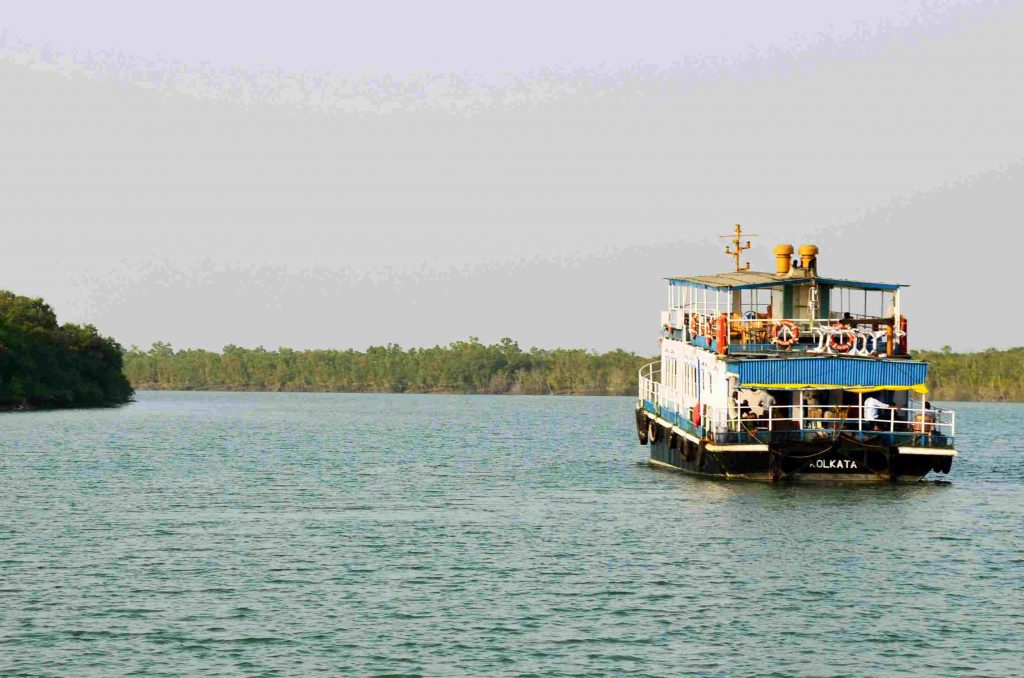
Best Time to Visit Sundarbans
The best time to visit the national park is from October to March. The weather during these months is pleasant and evenings are particularly soothing. Further, most animals come out of the dense forest to bask in the sun during winters on the banks of the rivers creating an excellent opportunity to spot them.
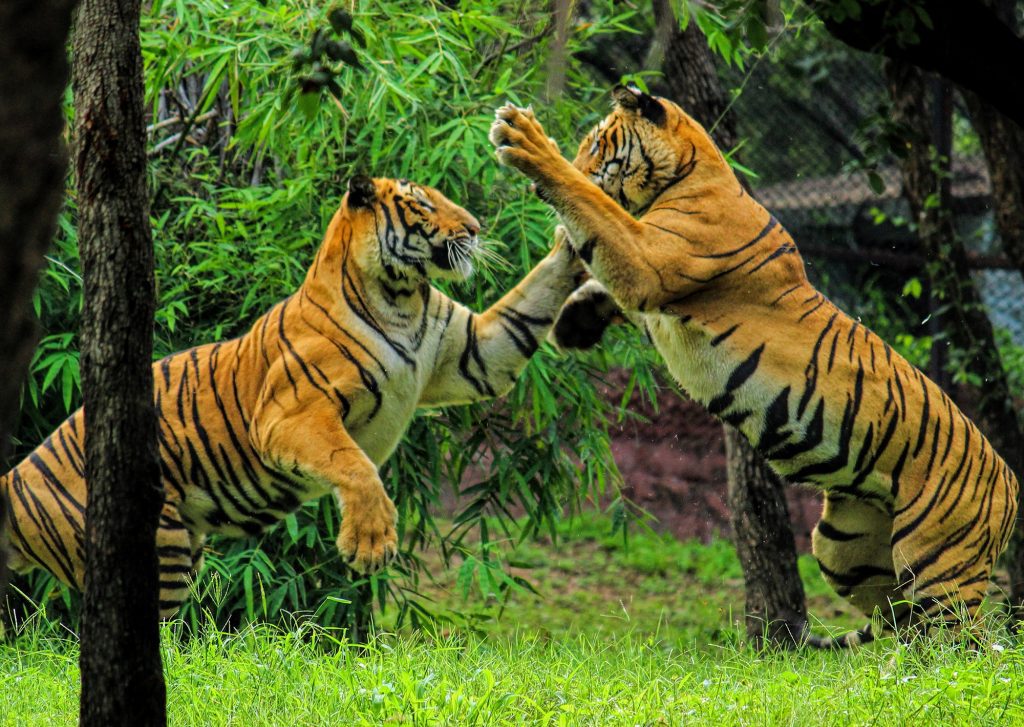
For those seeking to explore West Bengal in the summer months, here’s an 5-Day itinerary to the gorgeous north Bengal cities of Rishop, Kalimpong and Darjeeling.
Travel Tips for Visiting Sundarbans Wildlife Sanctuary
- Forests are peaceful and quiet. Hence, when you are there, ensure that you don’t make loud noises as it might send animals back into hiding.
- When going on a safari, wear soft colors like pastels. Avoid bright colors as they can affect animals in different ways.
- Follow all instructions of the safari guide. One mistake can put you in harm’s way.
- Avoid wearing strong perfumes.
- Wildlife sanctuaries do not allow tourists all around the year. Hence, make sure that you research thoroughly before commencing your journey.
- Pack according to the season. Check the weather update and ensure that you carry clothes accordingly.
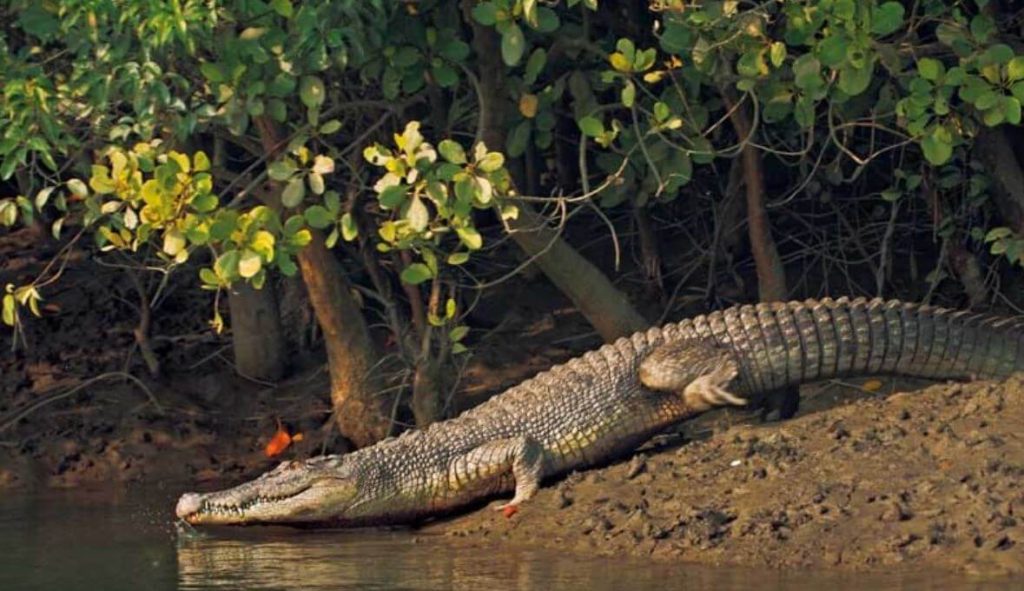
Sundarbans National Park Safari Timings and Entry Fee
The Park opens for tourists from September to March. The Safari timings are from 8.30 am to 4 pm on all days of the week.
The National Park entry fee is:
- Indians – Rs.60
- Foreigners – Rs.200
Additionally, you have to pay:
- Boat Entry Fee of Rs.400 per day for all zones except the interior Netidhopani zone
- Boat Entry Fee of Rs.800 for the interior Netidhopani zone
Resorts & Hotels to Stay in Sundarbans
Here is a list of resorts and hotels to stay in:
- Banani Resort
- Sunderbans Mangrove Retreat
- Sunderbans Tiger Land
- Sunderbans Tiger Camp
- Sunderban Tiger Roar
- Suranjana Holiday Resort
- Hotel Mainak Sunderbans
- Chital Tourist Lodge
- Sunderbans Apanjan Hotel
Have you taken a trip to the breathtaking Sundarbans? Let us know in the comments.
Best Road-Trips to Sundarbans National Park
| Route Name | Distance | Time |
| Kolkata to Sundarbans | 156 km | 3 hours and 13 minutes |
| Digha to Sundarbans | 479 km | 5 hours and 45 minutes |
| Siliguri to Sundarbans | 711 km | 14 hours |
| Darjeeling to Sundarbans | 552 km | 12 hours |

